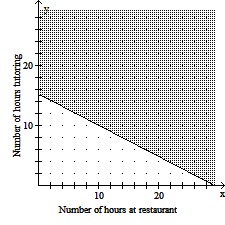For problems 1 - 3 find the discriminant and use it to describe the describe any real zeros.
A. 144, two rational zeros
B. 144, two irrational zeros
C. ![]() , two rational zeros
, two rational zeros
D. ![]() , no real zeros
, no real zeros
E. None of these
Answer: A
You might also like to view...
Solve and check the linear equation.0.40(30) + 0.70x = 0.60(30 + x)
A. {30} B. {70} C. {50} D. {60}
Solve the application involving a linear inequality and its graph. Carlos needs at least $380 to buy a new smartphone. He works x hours at a restaurant for $13 per hour and y hours as a tutor for $25 per hour. The inequality  models the amount of money Carlos must earn to buy the new phone. The inequality is graphed below.
models the amount of money Carlos must earn to buy the new phone. The inequality is graphed below.  Determine whether the ordered pair (15, 20) is a solution to the inequality and explain its real-world meaning.
Determine whether the ordered pair (15, 20) is a solution to the inequality and explain its real-world meaning.
A. (15, 20) is a solution. If Carlos works 15 hours at $25 per hour and 20 hours at $13 per hour, he will be able to purchase the new phone. B. (15, 20) is a solution. If Carlos works 15 hours at $13 per hour and 20 hours at $25 per hour, he will be able to purchase the new phone. C. (15, 20) is not a solution. If Carlos works 15 hours at $25 per hour and 20 hours at $13 per hour, he will not be able to purchase the new phone. D. (15, 20) is not a solution. If Carlos works 15 hours at $13 per hour and 20 hours at $25 per hour, he will not be able to purchase the new phone.
Simplify by using the order of operations. Round your answer to the nearest hundredth.3.72 + 7.8 - 4.8
A. 44.89 B. 6.7 C. 16.69 D. 10.4
Solve the equation using the quadratic formula. Simplify irrational solutions, if possible.x2 + 8x - 5 = 0
A. {-4 ± 2 }
}
B. {4 ±  }
}
C. {-1 ±  }
}
D. {-4 ±  }
}